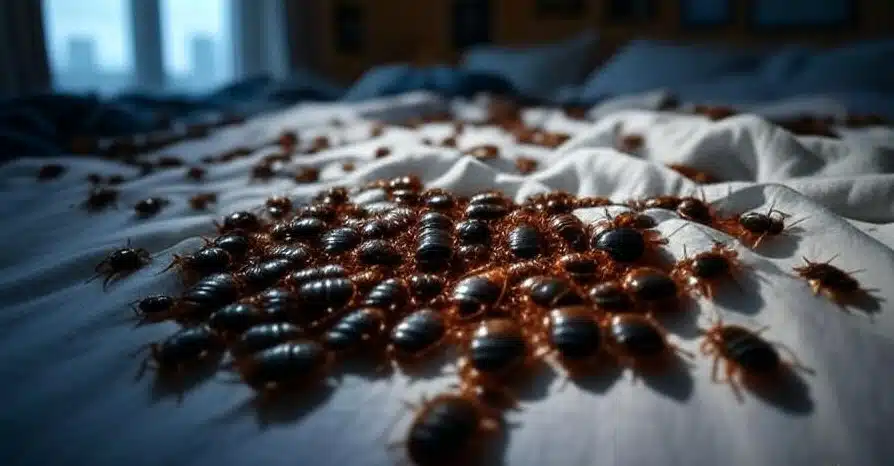
Bed bugs are a growing concern for London residents, often sparking worry about how these pests infiltrate our daily lives. A common question is: do bed bugs jump on your clothes? Understanding how bed bugs move and spread in a bustling city like London is crucial for preventing infestations in your home. This comprehensive guide explores whether bed bugs can jump onto clothing, how they spread, and practical steps to protect your wardrobe and living space, tailored for Londoners.
Do Bed Bugs Jump on Your Clothes?
The short answer is no, bed bugs do not jump on your clothes. Bed bugs (Cimex lectularius) are small, wingless insects that lack the ability to jump or fly, unlike fleas. However, they are skilled crawlers and can easily climb or crawl onto clothes, making clothing a common vehicle for their spread. In London’s busy urban environment, where people frequently move through crowded spaces like the Tube or markets, bed bugs can hitchhike on clothes, bags, or other items, finding their way into homes.
While bed bugs don’t actively leap onto clothing, they are attracted to human scents, body heat, and carbon dioxide, which can draw them to clothes left on beds, floors, or in infested areas. Once on clothing, they can hide in seams, folds, or pockets, making them difficult to detect.
How Bed Bugs Get Onto Clothes
Bed bugs typically end up on clothes through:
- Contact with Infested Areas: Clothes left on or near infested furniture, such as beds, sofas, or chairs, are prime targets for crawling bed bugs.
- Travel Exposure: In hotels, hostels, or public transport, bed bugs can crawl onto clothes from infested surfaces like seats or luggage racks.
- Shared Spaces: Communal laundrettes, gym lockers, or second-hand shops in London can inadvertently transfer bed bugs to clothing.
In areas like Shoreditch or Brixton, where shared living and frequent travel are common, the risk of bed bugs latching onto clothes is heightened.
How Long Can Bed Bugs Stay on Clothes?
Bed bugs can remain on clothes for days to weeks, depending on conditions. Without a blood meal, adult bed bugs can survive 6 to 12 months in ideal environments (e.g., cool, stable temperatures of 18–22°C, common in London homes). On clothes, they may hide in folds or seams, waiting for a chance to feed or move to a more suitable hiding spot, such as a mattress or wardrobe.
How Bed Bugs Spread in Your Home
Once bed bugs hitchhike onto your clothes, they can quickly spread throughout your home, especially in London’s compact flats or terraced houses. Here’s how they move:
From Clothes to Furniture
Clothes left on beds, sofas, or chairs allow bed bugs to crawl onto these surfaces, where they hide in seams, cushions, or cracks. From there, they can spread to nearby furniture, making bedrooms and living areas prime infestation zones.
Through Shared Spaces
In multi-occupancy buildings in boroughs like Hackney or Lambeth, bed bugs can spread between flats via shared laundry rooms or hallways. Infested clothes brought into these spaces can transfer bugs to other residents’ belongings.
Via Personal Items
Bags, backpacks, or shoes stored with infested clothes can carry bed bugs to other areas of the home, such as kitchens or bathrooms, though these are less common hiding spots. In London’s busy households, where clutter is common, bed bugs can find plenty of places to thrive.
Preventing Bed Bugs from Spreading via Clothes
Stopping bed bugs from spreading through your clothes requires proactive measures, especially in a city as dynamic as London. Here’s how to protect your wardrobe and home:
During Travel
- Inspect Accommodations: Check hotel or hostel rooms for bed bugs, focusing on mattresses, headboards, and furniture.
- Store Clothes Safely: Keep clothes in sealed plastic bags inside your suitcase, and avoid placing luggage on beds or upholstered surfaces.
- Unpack Outdoors: Upon returning, unpack clothes in a garage or outdoor area and wash immediately at 60°C.
At Home
- Wash and Dry Clothes: Wash all clothes at 60°C and dry on high heat for at least 30 minutes to kill bed bugs and eggs. For delicate items, seal in plastic bags and freeze at -18°C for 4 days.
- Minimise Clutter: Avoid leaving clothes on floors, beds, or sofas, as these are easy targets for bed bugs.
- Use Protective Bags: Store clean clothes in sealed plastic containers or bed bug-proof garment bags to prevent recontamination.
In Shared Spaces
In London’s communal laundrettes or multi-occupancy buildings:
- Transport laundry in sealed plastic bags to avoid cross-contamination.
- Run an empty hot cycle in washing machines before use to eliminate any lingering bed bugs.
- If you suspect an infestation, contact pest.co.uk’s bed bug treatment in London for professional advice and treatment.
Health Risks of Bed Bugs
Bed bugs on clothes can lead to bites, which appear as red, itchy welts, often in lines or clusters. While they don’t transmit diseases, scratching bites can cause secondary infections, and the stress of an infestation may affect sleep and mental health. For guidance on treating bites, visit the NHS guide on insect bites and stings.
When to Seek Professional Help
If you find bed bugs on your clothes or notice signs of an infestation—bites, blood spots, or live bugs—it’s time to act. In London, where infestations can spread rapidly in flats or shared buildings, professional treatment is often necessary. pest.co.uk offers expert solutions, including heat treatments and chemical applications, to eradicate bed bugs and prevent their return.
Conclusion: Stay Vigilant to Protect Your Home
Answering do bed bugs jump on your clothes, we’ve clarified that while bed bugs don’t jump, they can easily crawl onto clothing, spreading infestations in London’s busy households. By washing clothes at high temperatures, storing them safely, and taking precautions in shared spaces, you can keep your wardrobe and home bed bug-free. For expert support, trust ThermoPest Bed Bug Treatment London to deliver effective, tailored solutions, ensuring your home remains a pest-free sanctuary.
